Guidance and Tools
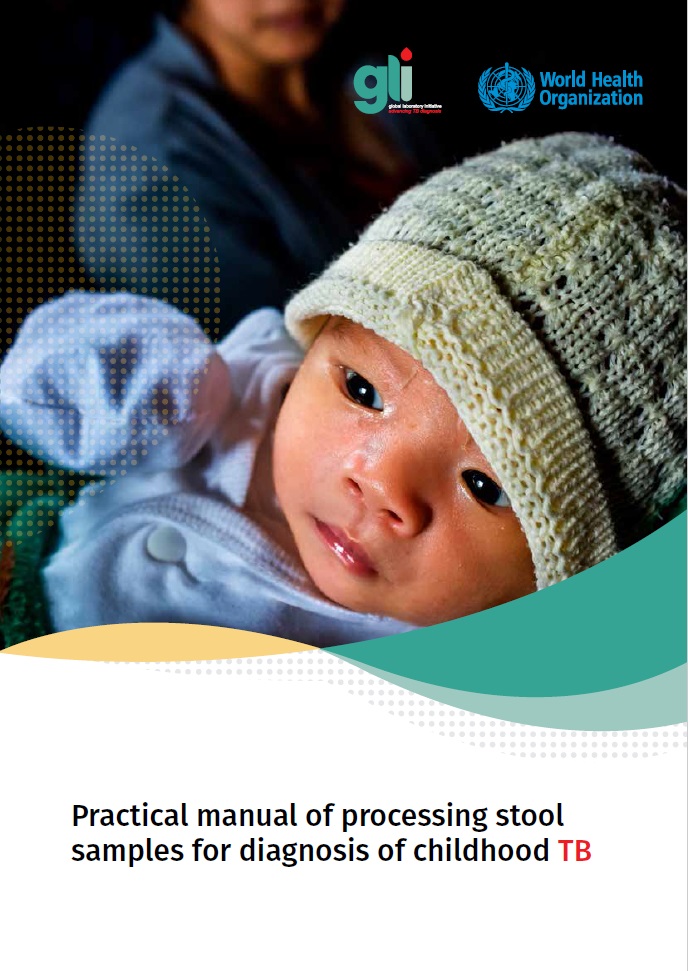 Practical manual of processing stool samples for diagnosis of childhood TB This manual was developed in response recommendations by WHO on the use of stool specimens from children for Xpert MTB/RIF and Xpert MTB/RIF Ultra testing. Two simple processing methods for the preparation of stool samples for Xpert testing are described. The manual also describes the requirements for the implementation of stool testing following 10 clear steps. Finally, the manual includes a checklist of activities for implementation and a laboratory assessment tool for monitoring and supervising laboratories that implement stool testing.
Practical manual of processing stool samples for diagnosis of childhood TB This manual was developed in response recommendations by WHO on the use of stool specimens from children for Xpert MTB/RIF and Xpert MTB/RIF Ultra testing. Two simple processing methods for the preparation of stool samples for Xpert testing are described. The manual also describes the requirements for the implementation of stool testing following 10 clear steps. Finally, the manual includes a checklist of activities for implementation and a laboratory assessment tool for monitoring and supervising laboratories that implement stool testing.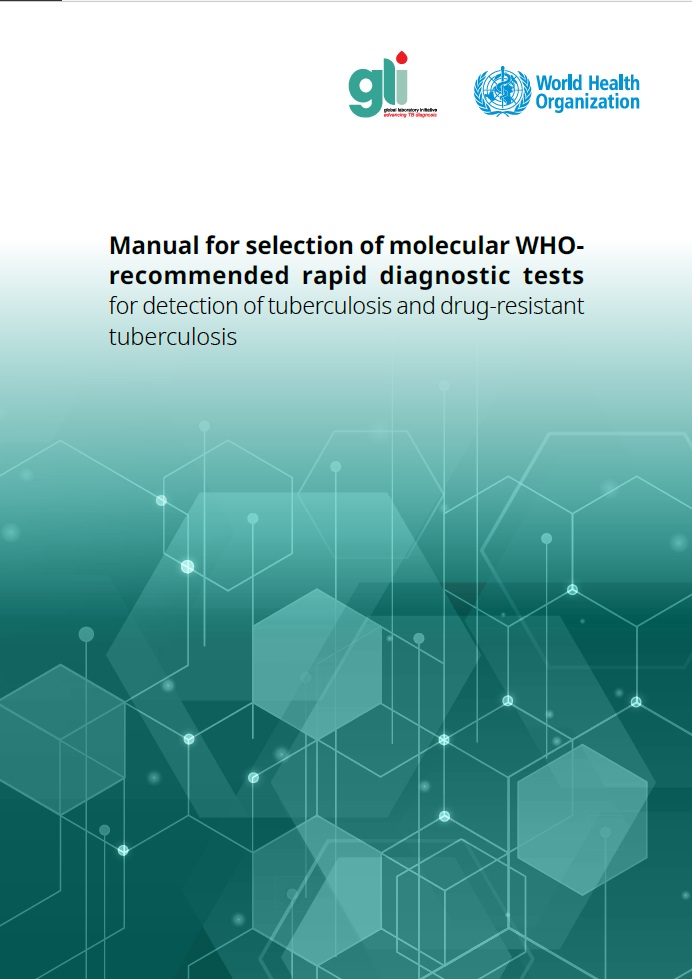 Manual for selection of molecular WHO recommended rapid diagnostic tests for detection of tuberculosis and drug-resistant tuberculosis This manual provides practical guidance on the selection of molecular WHO-recommended rapid diagnostic (mWRD) and drug resistance tests for TB and drug-resistant TB. It is designed to be suitable for use in any country, with a customizable approach that assists users to tailor their selection efforts based on their local context. The document includes a stepwise approach to selection of one or more mWRDs and a decision pathway to follow. It also includes a description of all mWRDs recommended by WHO as of December 2021, as well as key considerations and questions to ask when making a final mWRD selection to best meet patient and program needs.
Manual for selection of molecular WHO recommended rapid diagnostic tests for detection of tuberculosis and drug-resistant tuberculosis This manual provides practical guidance on the selection of molecular WHO-recommended rapid diagnostic (mWRD) and drug resistance tests for TB and drug-resistant TB. It is designed to be suitable for use in any country, with a customizable approach that assists users to tailor their selection efforts based on their local context. The document includes a stepwise approach to selection of one or more mWRDs and a decision pathway to follow. It also includes a description of all mWRDs recommended by WHO as of December 2021, as well as key considerations and questions to ask when making a final mWRD selection to best meet patient and program needs.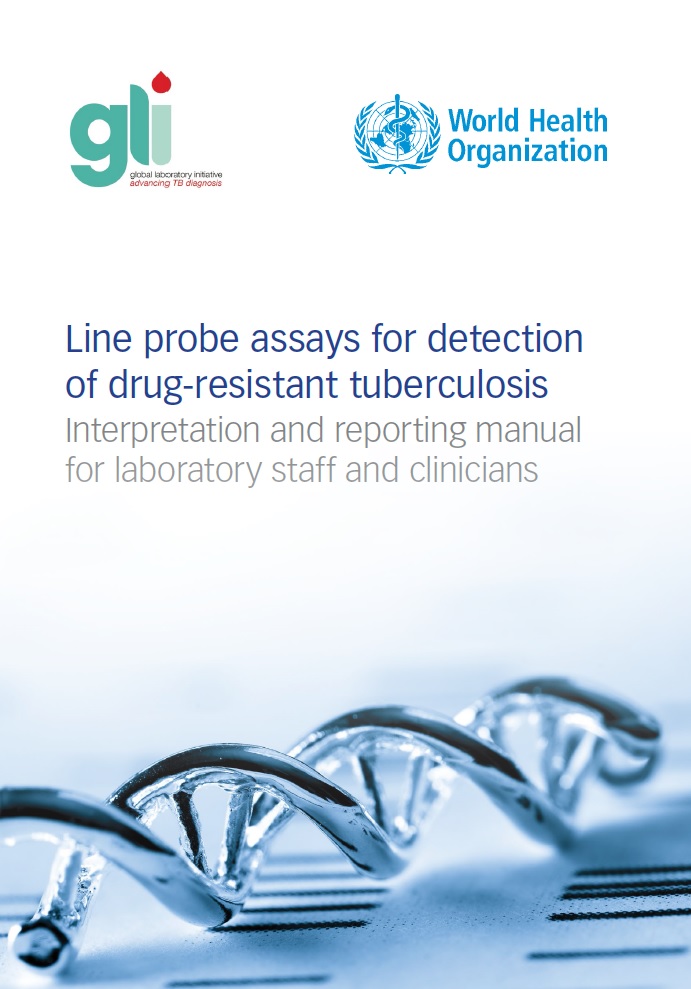 Line probe assays for detection of drug-resistant tuberculosis: interpretation and reporting manual for laboratory staff and clinicians This document was developed to provide practical guidance on interpretation of the most commonly used first- and second-line line probe assays (LPAs). In this updated manual, the interpretation of mutations identified by the assays has been revised to align with the WHO catalogue of mutations in Mycobacterium tuberculosis complex and their association with drug resistance. The latest LPA instructions for use of the assays are also presented. Lastly, case studies are provided that support staff at national and regional TB reference laboratories to understand and manage any discrepancies between phenotypic and genotypic drug susceptibility testing results
Line probe assays for detection of drug-resistant tuberculosis: interpretation and reporting manual for laboratory staff and clinicians This document was developed to provide practical guidance on interpretation of the most commonly used first- and second-line line probe assays (LPAs). In this updated manual, the interpretation of mutations identified by the assays has been revised to align with the WHO catalogue of mutations in Mycobacterium tuberculosis complex and their association with drug resistance. The latest LPA instructions for use of the assays are also presented. Lastly, case studies are provided that support staff at national and regional TB reference laboratories to understand and manage any discrepancies between phenotypic and genotypic drug susceptibility testing results Planning and Budgeting Tool for TB and drug resistant TB testing The Planning and Budgeting Tool for TB and Drug Resistant TB Testing facilitates systematic calculation of the quantities and costs of products for countries planning to order diagnostic products and laboratory supplies from the Global Drug Facility Catalog. The tool calculates the quantities of products required using each setting’s past consumption, or a morbidity-based forecasting method for all WHO recommended TB diagnostic products. It can also take into consideration targets for scaling up testing services according to the country’s epidemiology and their diagnostic algorithms.
Planning and Budgeting Tool for TB and drug resistant TB testing The Planning and Budgeting Tool for TB and Drug Resistant TB Testing facilitates systematic calculation of the quantities and costs of products for countries planning to order diagnostic products and laboratory supplies from the Global Drug Facility Catalog. The tool calculates the quantities of products required using each setting’s past consumption, or a morbidity-based forecasting method for all WHO recommended TB diagnostic products. It can also take into consideration targets for scaling up testing services according to the country’s epidemiology and their diagnostic algorithms.The product prices, article numbers and descriptions used in the tool are from the 2021 GDF Diagnostics Catalogue. The tool comprises a semi-automated, Excel Tool and a User Guide. Excel Tool tables are included for all WHO recommended diagnostic testing methods as well as items related to biosafety, cleaning, equipment maintenance and repair with reference to GDF article numbers and prices.
The tool is an updated version of a forecasting tool used in the EXPAND-TB project, developed by the Foundation for Innovative New Diagnostics (FIND), the Global Laboratory Initiative, the Global Drug Facility, and partners.
In addition to the GLI links below, the Tool and User Guide can also be found at WHO website.
Planning and budgeting tool for TB and drug resistant TB testing: calculation tool
Planning and budgeting tool for TB and drug resistant TB testing: User guide
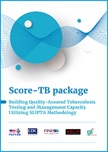 Score-TB package: The Score TB package has been developed to help laboratories assess the quality of test implementation in TB laboratories against international quality standards. Developed by the Foundation for Innovative New Diagnostics, in collaboration with the Global Laboratory Initiative, US Centers for Disease Control and Prevention and the African Society for Laboratory Medicine, the Score-TB Package consists of a User Guide, modular test-specific quality assessment scorecards and a quality management system assessment e-tool. All the tools are available in English, French and Portuguese. Access the full Score TB Package here.
Score-TB package: The Score TB package has been developed to help laboratories assess the quality of test implementation in TB laboratories against international quality standards. Developed by the Foundation for Innovative New Diagnostics, in collaboration with the Global Laboratory Initiative, US Centers for Disease Control and Prevention and the African Society for Laboratory Medicine, the Score-TB Package consists of a User Guide, modular test-specific quality assessment scorecards and a quality management system assessment e-tool. All the tools are available in English, French and Portuguese. Access the full Score TB Package here.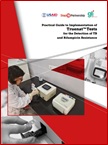 Practical Guide to Implementation of Truenat tests:: This guide provides practical guidance to plan for the adoption and implementation of the WHO-recommended Truenat tests for the rapid detection of TB and rifampicin resistance. It includes advice on how to translate findings from the WHO policy guidance into an actionable implementation plan, combined with operational considerations on use of the technology and initial field experience from early implementers. The guide also compiles as annexes a number of resources that can be easily adopted by programmes and sites, including a sample SOP for running the assays, checklists for planning and sites assessments, and job aids. The guide was developed in collaboration with the Stop TB Partnership and USAID.
Practical Guide to Implementation of Truenat tests:: This guide provides practical guidance to plan for the adoption and implementation of the WHO-recommended Truenat tests for the rapid detection of TB and rifampicin resistance. It includes advice on how to translate findings from the WHO policy guidance into an actionable implementation plan, combined with operational considerations on use of the technology and initial field experience from early implementers. The guide also compiles as annexes a number of resources that can be easily adopted by programmes and sites, including a sample SOP for running the assays, checklists for planning and sites assessments, and job aids. The guide was developed in collaboration with the Stop TB Partnership and USAID.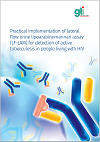 Practical implementation of LF-LAM for detection of active TB in people living with HIV: This guide has been developed to help countries implement the lateral-flow urine lipoarabinomannan assay (LF-LAM) and to incorporate this test into routine TB diagnostics algorithms. Additionally, the guide provides practical information on sample collection and storage, reading and interpretation as well as specific considerations for rolling out the test and procurement information. This guide is intended for national and subnational policymakers, front-line health workers, managers of HIV and TB programmes, and key TB stakeholders, including implementing partners. Available in English, French and Portuguese.
Practical implementation of LF-LAM for detection of active TB in people living with HIV: This guide has been developed to help countries implement the lateral-flow urine lipoarabinomannan assay (LF-LAM) and to incorporate this test into routine TB diagnostics algorithms. Additionally, the guide provides practical information on sample collection and storage, reading and interpretation as well as specific considerations for rolling out the test and procurement information. This guide is intended for national and subnational policymakers, front-line health workers, managers of HIV and TB programmes, and key TB stakeholders, including implementing partners. Available in English, French and Portuguese.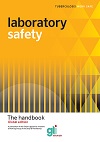 GLI TB Laboratory Safety Handbook: This guide has been developed to help reduce the risk of infection or injury, and protect the laboratory workforce and the wider community against unintentional exposures or releases of pathogenic biological agents. This handbook provides practical information and clear illustrations to assist laboratory staff in understanding the important safety issues related to the processing and management of samples potentially containing Mycobacterium tuberculosis. Available in English, French and Portuguese.
GLI TB Laboratory Safety Handbook: This guide has been developed to help reduce the risk of infection or injury, and protect the laboratory workforce and the wider community against unintentional exposures or releases of pathogenic biological agents. This handbook provides practical information and clear illustrations to assist laboratory staff in understanding the important safety issues related to the processing and management of samples potentially containing Mycobacterium tuberculosis. Available in English, French and Portuguese.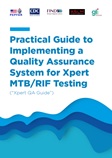 Implementing a Quality Assurance System for Xpert MTB/RIF Testing: The practical guide, and accompanying short guide, provide useful information and tools to establishing and implementing a quality assurance (QA) system for the Xpert MTB/RIF test across the diagnostic network. Topics covered in the guide include strategic planning, documentation, training and competency assessment, data connectivity, ensuring a safe and functional testing site, equipment and supplies, external quality assessment, monitoring quality indicators, and strengthening the laboratory-clinical interface. The guide is intended for implementers of the Xpert MTB/RIF test and QA managers across the laboratory diagnostic network.
Implementing a Quality Assurance System for Xpert MTB/RIF Testing: The practical guide, and accompanying short guide, provide useful information and tools to establishing and implementing a quality assurance (QA) system for the Xpert MTB/RIF test across the diagnostic network. Topics covered in the guide include strategic planning, documentation, training and competency assessment, data connectivity, ensuring a safe and functional testing site, equipment and supplies, external quality assessment, monitoring quality indicators, and strengthening the laboratory-clinical interface. The guide is intended for implementers of the Xpert MTB/RIF test and QA managers across the laboratory diagnostic network.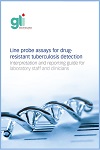 GLI guide for the interpretation and reporting of line probe assays: This guide has been developed to provide practical information on the interpretation of the most commonly used first- and second-line line probe assays (LPA). In addition to the interpretation of the mutations identified by the two assays, this guide includes practical recommendations on additional follow up diagnostic actions that should be performed in the presence of specific mutations and the clinical implications that these mutations have on the selection of appropriate tuberculosis treatment regimens. Additionally, the guide further illustrates individual case studies to demonstrate how information should be reported to clinicians, as well as examples of LPA results, and a recommended reporting template.
GLI guide for the interpretation and reporting of line probe assays: This guide has been developed to provide practical information on the interpretation of the most commonly used first- and second-line line probe assays (LPA). In addition to the interpretation of the mutations identified by the two assays, this guide includes practical recommendations on additional follow up diagnostic actions that should be performed in the presence of specific mutations and the clinical implications that these mutations have on the selection of appropriate tuberculosis treatment regimens. Additionally, the guide further illustrates individual case studies to demonstrate how information should be reported to clinicians, as well as examples of LPA results, and a recommended reporting template.Available in English, French, Portuguese, Russian, and Vietnamese.
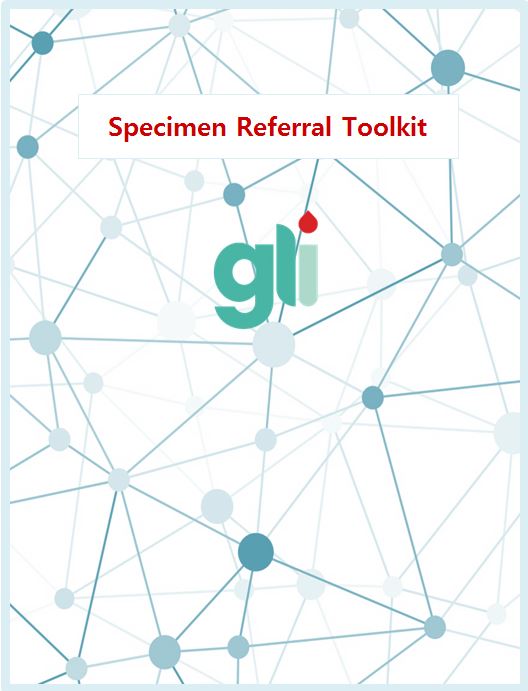 GLI Specimen Referral Toolkit: Building on the GLI Guide to TB Specimen Referral Systems and Integrated Networks, this toolkit not only underpins the essential components that must be considered when establishing or improving laboratory networks, but provides specific tools and materials available to all stakeholders working towards the optimization specimen referral networks. This Specimen Referral Toolkit contains examples of existing tools in use by countries and, newly developed tools which have been created to fill gaps in existing materials. All of the tools in the Toolkit are presented either by helpful tools for phases of developing or strengthening a specimen referral system, or by component of the system.
GLI Specimen Referral Toolkit: Building on the GLI Guide to TB Specimen Referral Systems and Integrated Networks, this toolkit not only underpins the essential components that must be considered when establishing or improving laboratory networks, but provides specific tools and materials available to all stakeholders working towards the optimization specimen referral networks. This Specimen Referral Toolkit contains examples of existing tools in use by countries and, newly developed tools which have been created to fill gaps in existing materials. All of the tools in the Toolkit are presented either by helpful tools for phases of developing or strengthening a specimen referral system, or by component of the system.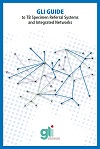 GLI Guide to TB Specimen Referral Systems and Integrated Networks: This guide describes the various phases to create and strengthen specimen referral systems, essential components involved in referral, as well as other considerations for TB programme and laboratory managers, Ministry of Health officials, and other stakeholders across disease programmes. In addition to describing transport mechanisms and equipment required to move specimens in a safe manner, this guide also provides information on logistics, results reporting, data management, monitoring and evaluation, and standard operating procedures that will facilitate and improve specimen referral systems.
GLI Guide to TB Specimen Referral Systems and Integrated Networks: This guide describes the various phases to create and strengthen specimen referral systems, essential components involved in referral, as well as other considerations for TB programme and laboratory managers, Ministry of Health officials, and other stakeholders across disease programmes. In addition to describing transport mechanisms and equipment required to move specimens in a safe manner, this guide also provides information on logistics, results reporting, data management, monitoring and evaluation, and standard operating procedures that will facilitate and improve specimen referral systems. GLI Planning for country transition to Xpert MTB/RIF Ultra Cartridges: this guide provides practical guidance to develop an actionable implementation plan to smoothly transition to use of Xpert MTB/RIF Ultra cartridges, ensuring uninterrupted service and avoiding cartridge wastage. Topics covered in the guide include adapting national guidelines and diagnostic algorithms; managing existing cartridge supply, forecasting, procurement and distribution; planning site-level computer software upgrades and trainings of laboratory personnel and clinicians; ensuring coordination among donors and partners supporting Xpert implementation in countries; and monitoring impact of the roll-out of Xpert MTB/RIF Ultra.
GLI Planning for country transition to Xpert MTB/RIF Ultra Cartridges: this guide provides practical guidance to develop an actionable implementation plan to smoothly transition to use of Xpert MTB/RIF Ultra cartridges, ensuring uninterrupted service and avoiding cartridge wastage. Topics covered in the guide include adapting national guidelines and diagnostic algorithms; managing existing cartridge supply, forecasting, procurement and distribution; planning site-level computer software upgrades and trainings of laboratory personnel and clinicians; ensuring coordination among donors and partners supporting Xpert implementation in countries; and monitoring impact of the roll-out of Xpert MTB/RIF Ultra. GLI Practical Guide to TB Laboratory Strengthening: This guide provides practical guidance on implementation of WHO recommendations and international best practices for TB laboratory strengthening. It is an updated version of the GLI Guide for Providing Technical Support to TB Laboratories, providing the latest practical guidance on use of newly recommended diagnostics in model algorithms, as well as guidance in key technical areas, including quality assurance and quality management systems, specimen collection and registration, procurement and supply-chain management, diagnostics connectivity, biosafety, data management, human resources, strategic planning and other topics. Providers of technical assistance may also use the guide as a reference for available resources and tools.
GLI Practical Guide to TB Laboratory Strengthening: This guide provides practical guidance on implementation of WHO recommendations and international best practices for TB laboratory strengthening. It is an updated version of the GLI Guide for Providing Technical Support to TB Laboratories, providing the latest practical guidance on use of newly recommended diagnostics in model algorithms, as well as guidance in key technical areas, including quality assurance and quality management systems, specimen collection and registration, procurement and supply-chain management, diagnostics connectivity, biosafety, data management, human resources, strategic planning and other topics. Providers of technical assistance may also use the guide as a reference for available resources and tools.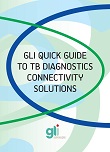 GLI Quick Guide to TB Diagnostics Connectivity Solutions: Newer diagnostics produce results data in digital format (also known as electronic data). Unlike written data on paper, electronic data can be rapidly and accurately sent and analysed using a diagnostics connectivity solution. These solutions give TB programmes the ability to remotely monitor network performance for quality assurance purposes, transmit test results automatically to clinicians, laboratory information management systems or electronic registers, and manage inventory at sites in real-time, along with other advantages. This guide provides an overview of diagnostics connectivity solutions, and what is required to establish one and use it effectively. Available in English, French, Portuguese, and Russian
GLI Quick Guide to TB Diagnostics Connectivity Solutions: Newer diagnostics produce results data in digital format (also known as electronic data). Unlike written data on paper, electronic data can be rapidly and accurately sent and analysed using a diagnostics connectivity solution. These solutions give TB programmes the ability to remotely monitor network performance for quality assurance purposes, transmit test results automatically to clinicians, laboratory information management systems or electronic registers, and manage inventory at sites in real-time, along with other advantages. This guide provides an overview of diagnostics connectivity solutions, and what is required to establish one and use it effectively. Available in English, French, Portuguese, and Russian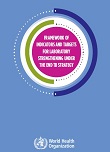 Framework of indicators and targets for laboratory strengthening under the End TB Strategy: This Framework, developed as a collaboration between the WHO Global TB Programme and the GLI core group, comprises 12 core indicators that measure countries’ capacity to detect TB accurately and rapidly using new diagnostics, provide universal DST, and ensure the quality of testing. The Framework serves as a guide for all countries developing plans for laboratory strengthening during 2016-2025, and also provides methods for calculating country-specific targets for the numbers of tests and facilities needed for each of the main diagnostic technologies.
Framework of indicators and targets for laboratory strengthening under the End TB Strategy: This Framework, developed as a collaboration between the WHO Global TB Programme and the GLI core group, comprises 12 core indicators that measure countries’ capacity to detect TB accurately and rapidly using new diagnostics, provide universal DST, and ensure the quality of testing. The Framework serves as a guide for all countries developing plans for laboratory strengthening during 2016-2025, and also provides methods for calculating country-specific targets for the numbers of tests and facilities needed for each of the main diagnostic technologies.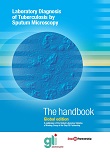 Laboratory Diagnosis of Tuberculosis by Sputum Microscopy - The GLI Handbook: Guidelines for sputum smear microscopy have been published by WHO and The Union, but in the decade since publication, many developments have occurred and a revised and updated text replacing both was considered timely. The GLI Handbook is a practical guide for the laboratory technician; it draws on the ideas outlines above and references best practice documents released by WHO and the GLI. The Handbook uses simple text and clear illustrations to assist laboratory staff in understanding the important issues involved in conducting sputum smear microscopy for the diagnosis of TB.
Laboratory Diagnosis of Tuberculosis by Sputum Microscopy - The GLI Handbook: Guidelines for sputum smear microscopy have been published by WHO and The Union, but in the decade since publication, many developments have occurred and a revised and updated text replacing both was considered timely. The GLI Handbook is a practical guide for the laboratory technician; it draws on the ideas outlines above and references best practice documents released by WHO and the GLI. The Handbook uses simple text and clear illustrations to assist laboratory staff in understanding the important issues involved in conducting sputum smear microscopy for the diagnosis of TB. GLI TB Microscopy Network Accreditation: an Assessment Tool: Although there are many international guidelines and technical materials for procedures and EQA, there is little or no external validation to assure that countries are adequately managing the microscopy networks. This accreditation tool is based on the many WHO-approved guidelines that provide technical direction, recommendations and specific forms to document and monitor performance of microscopy networks. The tool is composed of eleven standards with each a corresponding measure defining the minimum allowable performance to achieve accreditation.
GLI TB Microscopy Network Accreditation: an Assessment Tool: Although there are many international guidelines and technical materials for procedures and EQA, there is little or no external validation to assure that countries are adequately managing the microscopy networks. This accreditation tool is based on the many WHO-approved guidelines that provide technical direction, recommendations and specific forms to document and monitor performance of microscopy networks. The tool is composed of eleven standards with each a corresponding measure defining the minimum allowable performance to achieve accreditation.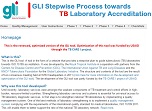 GLI Stepwise Process towards TB Laboratory Accreditation: One of the best methods of laboratory strengthening is to implement a quality management system complying with the requirements of the international quality standard for medical laboratories, ISO 15189:2011. This website provides a stepwise plan to guide TB laboratories towards ISO 15189 accreditation. It was developed by the Royal Tropical Institute in cooperation with partners from the Centers for Disease Control and Prevention (CDC), The International Union Against TB and Lung Diseases and the KNCV Tuberculosis Foundation. The structure and contents of the tool are the result of two consensus meeting held at WHO headquarters in 2011.
GLI Stepwise Process towards TB Laboratory Accreditation: One of the best methods of laboratory strengthening is to implement a quality management system complying with the requirements of the international quality standard for medical laboratories, ISO 15189:2011. This website provides a stepwise plan to guide TB laboratories towards ISO 15189 accreditation. It was developed by the Royal Tropical Institute in cooperation with partners from the Centers for Disease Control and Prevention (CDC), The International Union Against TB and Lung Diseases and the KNCV Tuberculosis Foundation. The structure and contents of the tool are the result of two consensus meeting held at WHO headquarters in 2011.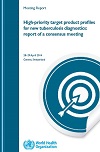 GLI/NDWG Meeting report on high-priority target product profiles for new TB diagnostics: Diagnostic manufacturers are increasingly expressing the need to be informed about the type of TB diagnostics they should invest in, as well as the potential market size for these products. The development of target product profiles (TPPs) is therefore an important step to align the needs of end-users with the specifications and targets that product developers should meet in terms of the performance and operational characteristics of such tests. Consensus on the minimal and optimal specifications of four different types of TB diagnostic tests has been reached following a meeting convened by WHO on behalf of GLI and the New Diagnostics Working Group.
GLI/NDWG Meeting report on high-priority target product profiles for new TB diagnostics: Diagnostic manufacturers are increasingly expressing the need to be informed about the type of TB diagnostics they should invest in, as well as the potential market size for these products. The development of target product profiles (TPPs) is therefore an important step to align the needs of end-users with the specifications and targets that product developers should meet in terms of the performance and operational characteristics of such tests. Consensus on the minimal and optimal specifications of four different types of TB diagnostic tests has been reached following a meeting convened by WHO on behalf of GLI and the New Diagnostics Working Group.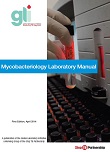 GLI Mycobacteriology Laboratory manual: This document describes standardized procedures related to sputum collection, handling, analyses, and reporting, with a focus on testing that has the greatest impact on microbiology endpoints for MDR-TB clinical trials (sputum culture conversion in liquid and solid media).
GLI Mycobacteriology Laboratory manual: This document describes standardized procedures related to sputum collection, handling, analyses, and reporting, with a focus on testing that has the greatest impact on microbiology endpoints for MDR-TB clinical trials (sputum culture conversion in liquid and solid media).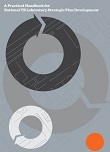 GLI Practical Handbook for National TB Laboratory Strategic Plan Development: This handbook is designed to guide simplified steps for national TB control programmes to develop a TB-specific national laboratory strategic plan. Accompanying the handbook is a Facilitator’s Manual and Participant’s Manual.
GLI Practical Handbook for National TB Laboratory Strategic Plan Development: This handbook is designed to guide simplified steps for national TB control programmes to develop a TB-specific national laboratory strategic plan. Accompanying the handbook is a Facilitator’s Manual and Participant’s Manual.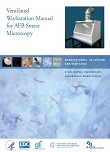 GLI Ventilated Workstation Manual for AFB Smear Microscopy: Laboratories performing AFB smear microscopy as well as Xpert MTB/RIF require adequate ventilation to minimize the occupational risk of infection. However, this is difficult to achieve in many settings where facilities have limited airflow, and where commercially produced biosafety cabinets are not affordable or appropriate. This guide provides specifications for the manufacture of a ventilated workstation that has been validated.
GLI Ventilated Workstation Manual for AFB Smear Microscopy: Laboratories performing AFB smear microscopy as well as Xpert MTB/RIF require adequate ventilation to minimize the occupational risk of infection. However, this is difficult to achieve in many settings where facilities have limited airflow, and where commercially produced biosafety cabinets are not affordable or appropriate. This guide provides specifications for the manufacture of a ventilated workstation that has been validated.The GLI Laboratory Toolbox
Download the complete Toolbox (VERY LARGE zipped package 188 MB)
Logistics Supply Management Tool
AFBsuppliesProcurementVs2
CU&DSTsupplies
Guidance for countries on the specifications for managing TB laboratory equipments and supplies
UserGuide_AFBlabSupplies
UserGuide_SuppliesCU&DSTworkbook
External Quality Assurance Package
AFB microscopy
EQA Overview & Planning
Facilitator Guide
Optional Modules
Panel Tests
Rechecking
Supervision
Management Information System
Culture & DST
French Versions
Microscopy & EQA
Partner Guidance and Tools

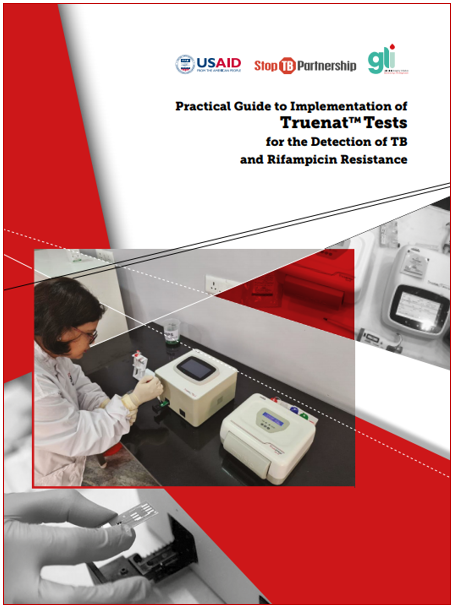 Practical Guide to Implementation of Truenat tests
Practical Guide to Implementation of Truenat tests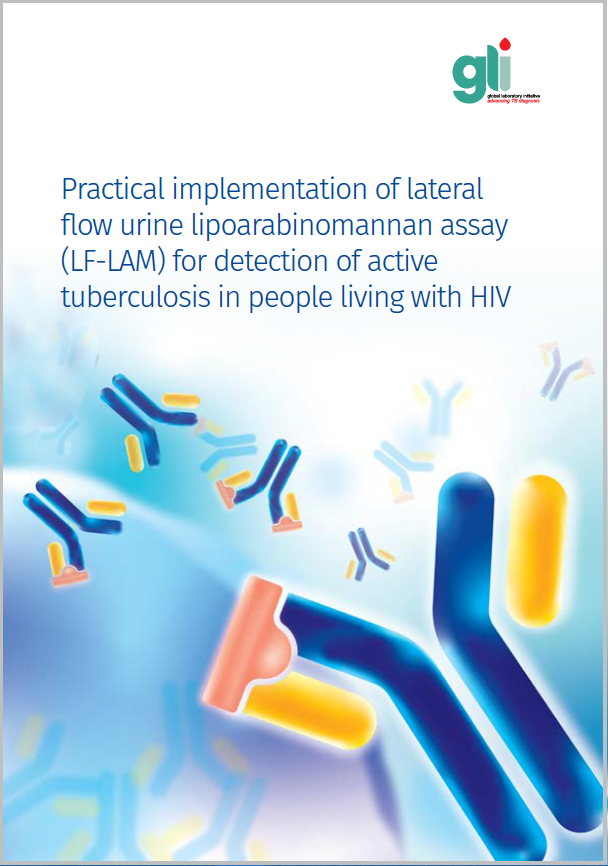 Practical implementation of LF-LAM for detection of active TB in people living with HIV
Practical implementation of LF-LAM for detection of active TB in people living with HIV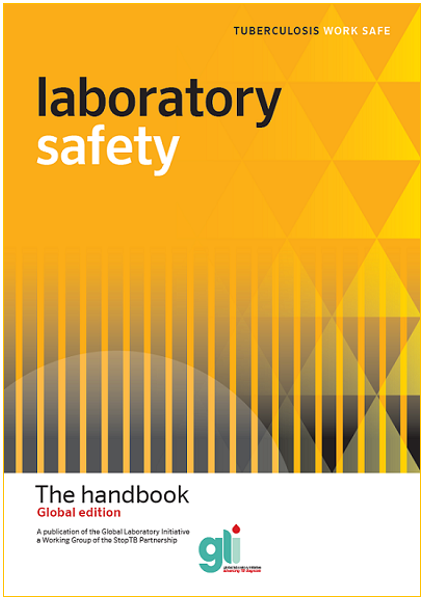 GLI TB Laboratory Safety Handbook
GLI TB Laboratory Safety Handbook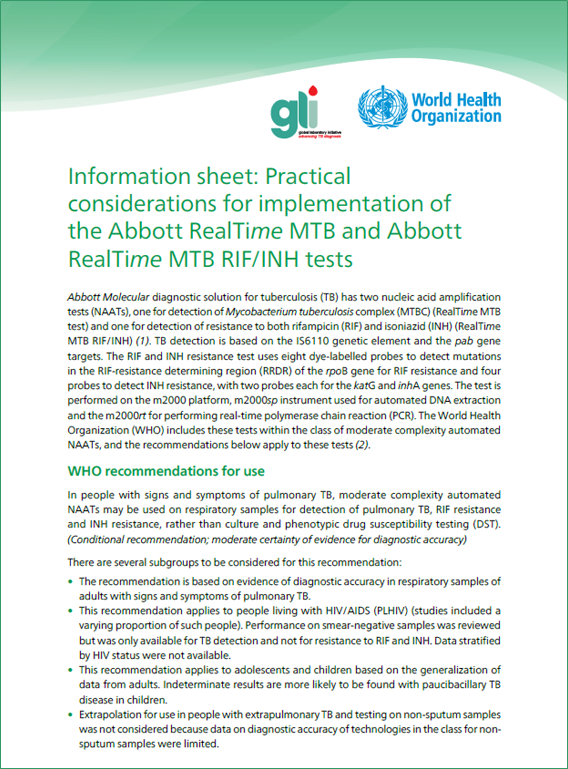 Practical considerations for implementation of the Abbott RealTime MTB and Abbott RealTime MTB RIF/INH tests
Practical considerations for implementation of the Abbott RealTime MTB and Abbott RealTime MTB RIF/INH tests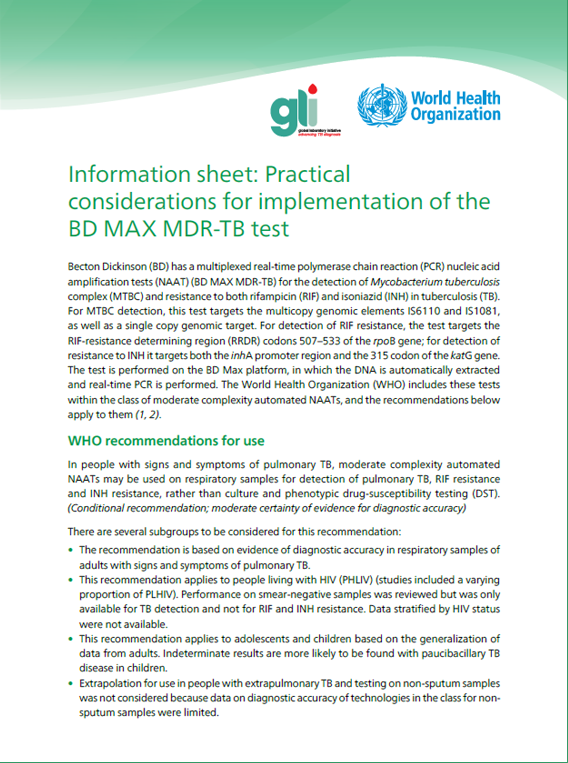 Practical considerations for implementation of the BD MAX MDR-TB test
Practical considerations for implementation of the BD MAX MDR-TB test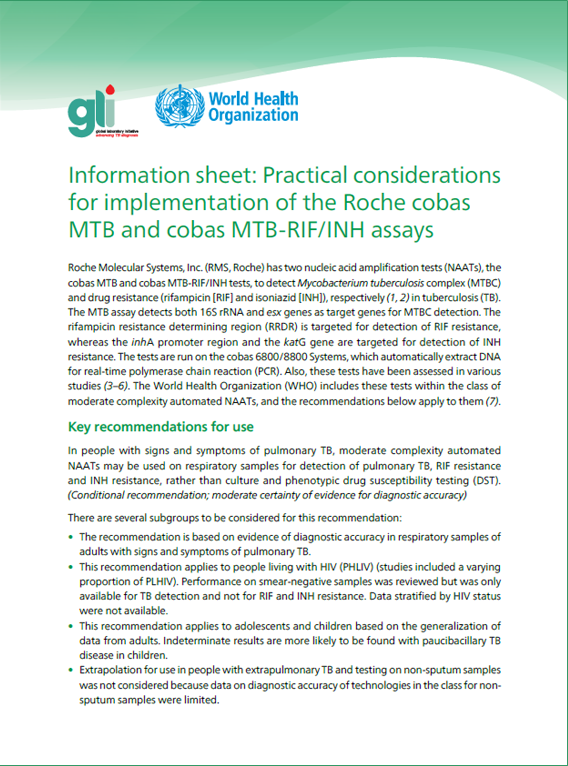 Practical considerations for implementation of the Roche cobas MTB and cobas MTB-RIF/INH assays
Practical considerations for implementation of the Roche cobas MTB and cobas MTB-RIF/INH assays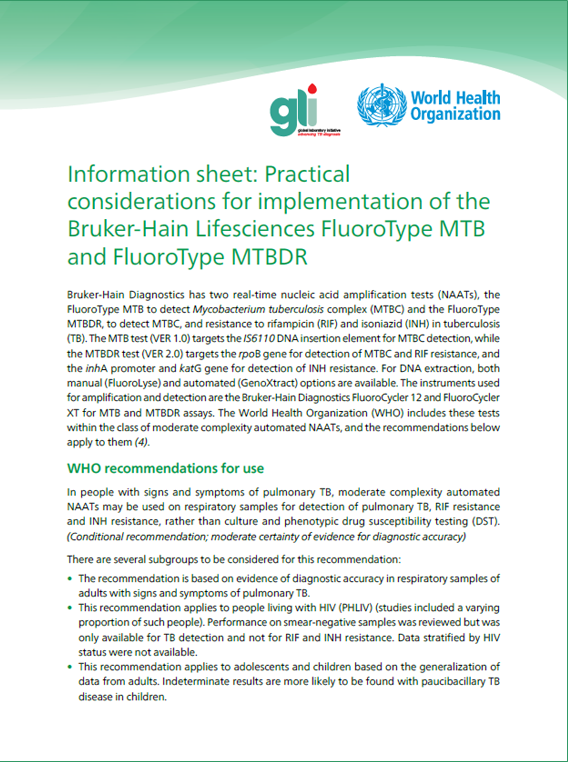 Practical considerations for implementation of the Bruker-Hain Lifesciences FluoroType MTB and FluoroType MTBDR
Practical considerations for implementation of the Bruker-Hain Lifesciences FluoroType MTB and FluoroType MTBDR Practical considerations for implementation of the Cepheid Xpert MTB/XDR test
Practical considerations for implementation of the Cepheid Xpert MTB/XDR test Practical considerations for implementation of the Nipro Genoscholar PZA-TB II assay
Practical considerations for implementation of the Nipro Genoscholar PZA-TB II assay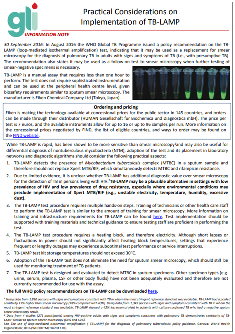 Practical considerations for implementation of the loop-mediated isothermal amplification (TB-LAMP) test
Practical considerations for implementation of the loop-mediated isothermal amplification (TB-LAMP) test